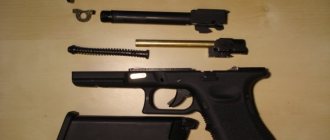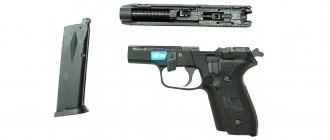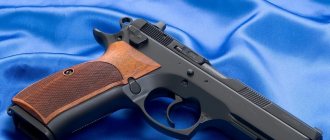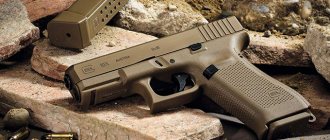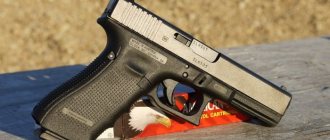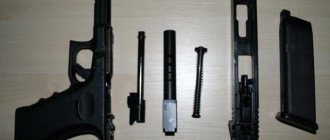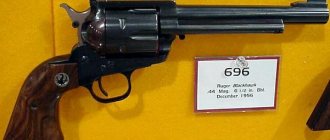Luger R.08 Parabellum - video
The introduction of smokeless powders kicked off the rapid development of automatic weapons, including self-loading pistols. In 1893, Berlin began producing the Hugo Borchard self-loading pistol. Although various "automatic" pistol systems had been proposed before, Borchardt was the first to achieve commercial success, which encouraged continued work. In 1898, Georg Johann Lueger, who served at , the successor of the Lewe company), significantly improved the Borchard system. The pistol has become more compact and lighter, and ergonomics have improved. Luger also modified the 7.65 mm Borchard cartridge with a bottle sleeve, a central location of the primer and a jacketed bullet.
In 1900, the pistol was adopted by the Swiss army. Only after this did DWM begin releasing the 7.65 mm Luger-Borchardt pistol (or simply “Luger”) onto the market. The pistol became better known as the “Parabellum”. The combination "Parabellum" - the second part of the famous Latin phrase "Si vis pacem, parabellum" ("Who wants peace, prepare for war") - was the telegraph code for DWM, was perceived as a trademark and as such became the designation of the newly introduced pistol. In 1902, Luger, based on the 7.65 mm, created a 9 mm cartridge for a military pistol. It is believed that the requirement to increase the caliber of the military pistol was put forward based on the experience of close combat during the suppression of the Yihetuan uprising ("Boxer Rebellion") in China in 1900, which revealed the insufficient stopping effect of the 7.65 mm cartridge bullet. When the caliber was increased to 9 mm, the base cartridge case was transformed from a bottle case into a cylindrical case by expanding the barrel. The 9-mm bullet initially had a cylindrical-conical shape with a flat platform on top, but since 1915 the cartridge was equipped with a cylindrical-ogive bullet, and this option became the main one.
During the modernizations of 1902–1906. A number of changes were made to the system of the pistol itself. This is how the so-called “Luger new” system was formed. In 1904, the German Navy adopted a 9 mm pistol model with a rear sight and a barrel length of 150 mm. In August 1908, the Reichswehr adopted a 9 mm model with a fixed sight and a 102 mm barrel under the designation P.08. Since DWM could not provide large supplies while maintaining proper quality, the arsenal in Erfurt was involved in fulfilling the order. There was also a “naval” model of 1908 with the same elongated barrel and reversible rear sight.
Pistol Luger R.08 Parabellum left view
The automatic pistol operated according to a short-stroke recoil pattern. Locking the barrel bore with the bolt was ensured by a system of two hinged levers located at the “dead center”. When the barrel and the bolt moved back, the rollers of the lever hinge ran onto the frame's ridges, the levers folded, unlocking the barrel bore and moving the bolt away from the barrel. At the same time, the return spring, located in the handle and connected by a crank lever to the rear locking lever, was compressed. The ejector located on top also served as an indicator of the presence of a cartridge in the chamber.
The striker-type trigger mechanism provided a shot only with preliminary cocking of the striker. Some of the trigger mechanism parts are installed on the left side of the frame; in combination with the “buttons” of the hinge, this increased the transverse size of the pistol. The safety lever in the lower position blocked the trigger lever and the movable automation system. A number of models, including “commercial” versions of the R.08, were equipped with an automatic safety device in the form of a button behind the handle - this safety device was automatically turned off when the handle was fully covered with the palm.
Pistol Luger R.08 Parabellum right view
A single-row magazine was inserted into the handle. When the cartridges were used up, the magazine feeder activated the bolt stop (introduced in 1913). Comfortable tilt and size of the handle, good balance contribute to shooting accuracy. Together with the power of the cartridge and the convenient location of the magazine latch, this determined the success of the pistol. The Parabellum system proved to be very sensitive, required complex machining and high precision parts, included many small parts, and yet remained popular for many years and in many countries due to the quality of its workmanship. Parabellum pistols of various models and calibers were at different times in service in three dozen countries, including Afghanistan, Bulgaria, Brazil, Holland, Greece, Denmark, Israel, Iran, China, Latvia, Lithuania, Portugal, Turkey, Finland, France , Chad, Switzerland, Sweden, Estonia. Pistols were also assembled in Switzerland, Great Britain, and Belgium. In Russia, Borchard-Luger pistols were not accepted for service, but back in 1907, the 9-mm Parabellum was recommended for officers to purchase at their own expense.
The finest hour of “Parabellum” can be called the First World War. By August 1914, the German armed forces had 250,000 R.08. In total, from the beginning of production to 1918, about 1,572,000 R.08 pistols were produced. The Reichswehr was also supplied with the LP.08 model with a barrel length of 200 mm, a sector sight up to 800 m (the capabilities of the weapon were significantly overestimated), and an attached holster-butt. This model was adopted in 1913 for the calculations of field artillery and fortress troops and is often referred to as “artillery”. In 1917, the LP.08 was equipped with a 32-round drum magazine.
In addition to the standard version P.08, in the early 1930s. Mauser-Werke AG has also begun production of a special version with an expansion type muffler. Special services such as the SD, Gestapo and military intelligence, the Abwehr, began to receive these weapons.
Having ceased production in 1920, DWM resumed it in 1923 under the name Berlin Karlsruhe Industrie Werke. In accordance with the restrictions of the Treaty of Versailles, only the 7.65 mm model with a barrel length of up to 100 mm was produced. Since 1930, the production of pistols, along with the rights, passed to Mauser Werke AG. For the Reichswehr and police, the R.08 was produced in reduced quantities and only . But in 1934, mass production of R.08 was resumed in Nazi Germany. It continued with Heinrich Krieghof until 1942. A total of 2,810,000 R.08 pistols were produced since its adoption, not counting other models.
Luger P.08 Parabellum pistol with an under-barrel flashlight. Such pistols were in service with the Imperial Security Service (RSD).
DWM
DWM - Deutsche Waffen und Munitionsfabriken (English)Russian. - a German factory for the production of weapons and ammunition, founded in 1889, Karlsruhe, Baden-Württemberg. Since 1896, the headquarters has been in Berlin on Kaiserin-Augusta-Allee.
In the Luger pistol, unlike the Borchardt pistol, when folded, the levers did not rest against the leaf return spring, but against the protrusion of the pistol frame. The leaf return spring moved into the handle and was then replaced with a coiled one. These changes made it possible to significantly reduce the size and weight of the pistol without compromising its service and operational characteristics.
In 1898, 49-year-old engineer Georg Johann Luger presented a sample of his 7.65 mm pistol with a barrel length of 122 mm, under the name Versuchsmodelle III (experimental model no. 3), to the Swiss government for purchase. Tests of this weapon took place in 1899,
On September 30, 1899, Georg Luger patented a number of his ideas embodied in a new pistol model.
On May 4, 1900, by parliamentary decree, the pistol was adopted by the Swiss army under the name “Pistole, Ordonnanz 1900, System Borchardt-Luger.” DWM has committed to producing 3,000 pistols of this system for the Swiss army.
After this, 7.65 mm Luger pistols entered service with a number of other countries; they were purchased by Brazil, Holland, Portugal, Russia and Turkey. In 1902, 1,000 Luger Model 1900 pistols were purchased by the US government for testing by the armed forces.
In the summer of 1902, competitive tests began in Germany in the vicinity of Berlin to select and adopt a self-loading pistol for the Kaiser's army.
They included: 7.65 mm Borchardt C93 pistol, 7.65 mm Luger pistol model 1900, 7.63 mm Mannlicher M.1900 pistol, 9 mm Mars pistol, 7.63- mm pistol "Schwarzlose" M.1893 "Standard", 9-mm pistol "Browning" and 7.63-mm pistol Mauser C-96.
The tests took quite a long time: only by 1904 was the winner announced - a modified Luger pistol.
In 1903, during testing, the caliber of the weapon was changed, since in 1902 a more powerful 9x19 mm cylindrical pistol cartridge with smokeless powder was developed, converted from a 7.65 mm “bottle” cartridge.
In the same year, the head of the DWM company gave the pistol the name “Parabellum” - from the famous Latin proverb “Si vis pacem, para bellum” (from Latin - “If you want peace, prepare for war”), which served as the motto of the DWM company. This is also the name given to its cartridge - 9x19 mm "Parabellum".
On December 12, 1904, the 9-mm Luger pistol “Marine Model 1904 of the Borchardt-Luger system” was adopted by the German naval headquarters for service with the German fleet.
On August 22, 1908, the 9 mm Luger pistol called P08 (Pistole 08) was adopted by the Kaiser's army as a standard short-barreled weapon.
It is worth saying that DWM, after adopting the pistol in Germany, used the name “Parabellum” only for commercial pistols.
The automatic operation of the pistol works according to the scheme of using recoil with a short barrel stroke. The barrel bore is locked using a system of hinged levers that are in the normal position and when firing a shot in the “dead center” position. In this state, folding of the levers under the influence of the linear pressure of the bolt when fired is excluded.
The moving system of the weapon consists of a barrel with a receiver, inside which parts of the locking mechanism and the impact mechanism are mounted. The barrel (with the front sight on the muzzle) is connected to the receiver using a threaded connection.
Models and their differences
M.1900
The Model 1900 was the earliest version of the Luger pistol. It was adopted by the Swiss army in 1900. This model inherited one feature inherent in Borchard pistols - a small bracket on the right side of the bolt hinge. Its task was to prevent the shutter from rebounding after it was closed. In reality it was unnecessary because when the bolt hinge is closed it is slightly below the line along which the recoil force acts, and therefore any action aimed at opening the bolt only pressed the hinge further against the receiver. Important elements of the M.1900 were a safety lever blocking the receiver, which was on the left rear of the frame, and a spring ejector, which was located on the flat top surface of the bolt. The M.1900 was chambered for the 7.65×21 mm cartridge. Barrel length 122 mm.
M.1902
M.1902 is a further development of the M.1900 variant. This model was created for the 9x19 mm Parabellum cartridge, as a result of which the barrel had to be made somewhat thicker and shorter than that of the previous model. Barrel length 102 mm. The bolt and magazine were also slightly modified. The number of rifling in the barrel was increased from four to six, and the dimensions of the frame and receiver became the same. In the final version of the M.1902, the frame, receiver and threaded barrel bushing were shortened by approximately 2 mm.
M.1904
The M.1904 variant became the first mass-produced version of the Luger pistol. The first purchase of this weapon occurred after the German Navy adopted the “9-mm Selbstladepistole 1904” with a barrel length of 147.32 mm, later known as the “naval model”. Certain innovations were introduced into the M.1904 variant, which then became standard for all Luger pistols. The conventional spring ejector has been replaced by a new type of ejector with a vertical tooth. The ejector is combined with an indicator of the presence of a cartridge in the chamber. The cartridge in the chamber raises the ejector upward. This model has a reversible sight at a distance of 100 and 200 m. At the bottom of the back of the handle there is a groove for attaching a holster-butt. Caliber 9 mm, length 262 mm, barrel length 147 mm, weight 915 g, muzzle velocity 350 m/s. From 1905 to 1918, DWM manufactured 81,250 Model 1904 pistols for the German Navy.
M.1906
For the first time, major changes were made to the M.1906 variant. The leaf return spring in the handle was replaced with a twisted, cylindrical one. The fuse design has also been changed; he himself was moved down and began to lock the sear. The top of the bolt was now semicircular, the hinge grips were made with a flat, diamond-shaped surface, and the anti-bounce bracket was removed. The M.1906 (or, as it came to be called, the “New Model Parabellum”) was manufactured in two versions - chambered for the 7.65 mm cartridge with a barrel length of 122 mm and for the 9 mm cartridge with a thicker barrel length of 102 mm.
M.1908
The Luger pistol of the 1908 model differs from the M.1906 in that the automatic safety was removed and only the flag safety remained. The M.1908 was most often called simply "Pistol 08", or P08. Like the 1906 model pistol, it has a cylindrical coiled return spring and an extractor, which is combined with an indicator of the presence of a cartridge in the chamber. With all the changes, the new “marine model” of 1904 was produced with the same name. In total, until 1918, the DWM weapons company produced 908,275 P08 for arming the army and 1,500 pistols for civilian purposes. In Erfurt, from 1911 to 1918, 663,600 units were produced.
9mm Parabellum pistol P.08 Lange
Artillery model
The so-called “Artillery Model” - a version of the 9 mm Luger pistol, called the Lange P08 (LP 08), was adopted on June 3, 1913 by units of Prussia, Saxony and Württemberg. This pistol-carbine is designed for shooting up to 800 m with an attached wooden holster-butt. The pistol is intended to arm crews of field artillery guns and non-commissioned officers of machine gun teams.
LP 08 with drum and stock
LP 08 with drum and stock
Advantages
— A fairly advanced design of a military pistol at the time of its creation. — Generally reliable operation in difficult operating conditions. — Convenient handle shape. — Excellent controllability when shooting. — Very little toss and recoil when fired. — Exceptional accuracy and accuracy of shooting, both aimed and offhand. — Robust and reliable design. — High rate of fire.
Flaws
— Many details of complex shape. Even the trigger has an intricate crescent shape. Its second end is a limiter, which should have another place. When descending from above, the other end of the crescent lowers, preventing you from shooting with gloves on. — The design does not allow closing the locking levers, protecting them from dirt or sand getting into the mechanism, which can cause a delay if a lot of dirt gets into the mechanism. — Delays when using cartridges with non-ogive bullets. — You cannot use cartridges with an increased charge of gunpowder for shooting to avoid damaging the weapon. — When shooting from the stomach, cartridges often fly into the shooter’s face.
Like other weapons of the early 20th century, the Luger was not highly technologically advanced. During the period of greatest production intensity, Mauser-Werke AG spent 12.5 man-hours on the production of one Luger; its production was quite labor-intensive. With the mass of the pistol itself being 0.87 kg, 6.1 kg of metal was required to produce it. During manufacturing, 778 separate operations were performed: 642 operations on machine equipment and 136 manually.
In 1939, the production cost of one Luger pistol by Mauser-Werke AG was 11.5 Reichsmarks, and the magazine for it was 3.15 Reichsmarks. The cost of a complete Luger pistol with two magazines was 17.8 Reichsmarks; the Mauser sold to the Wehrmacht more expensively - for 32 Reichsmarks, while the Mauser 98k rifle cost 70 Reichsmarks, and the MG-34 machine gun (itself expensive and replaced for this reason on MG-42) cost the Wehrmacht 300 Reichsmarks.
Receiver
The receiver and barrel are shaped like a tuning fork. Inside the fork of the tuning fork, a shutter with an impact mechanism and an ejector is placed and moves. The bolt is articulated with a connecting rod (front lever of the locking system), and the latter with a crank (rear lever). The crank at the junction with the connecting rod has two rollers with a notched surface, made with it as one whole, which give the weapon a characteristic, recognizable look. When the bolt is closed, the crank and connecting rod rest on the receiver so that the axis of the middle hinge becomes lower than the axes of the front and rear hinges, and thus the barrel bore is reliably locked by the bolt, since the connecting rod and crank form an obtuse angle with each other, with its apex facing down. The entire hinge-lever system of the pistol is a crank mechanism, in which the slide is the bolt. The barrel and receiver, assembled with their parts, can move in the grooves of the frame in the longitudinal direction.
The striker-type trigger mechanism is equipped with a disconnector, which allows only single fire.
The firing pin is located inside the bolt and is cocked when the levers are folded and the mainspring is compressed by the front protrusion of the bolt lever behind the side protrusion of the firing pin.
The mainspring is located in the cylindrical cavity of the firing pin and its end rests against the rear wall of the bolt. The side protrusion of the firing pin is located on the left, at the rear of the firing pin, and can move in the longitudinal window of the bolt. Part of the profile of this protrusion is a combat platoon. The cocked firing pin is held in the cocked position by a spring-loaded trigger lever.
The ejector is located on top of the bolt and also serves as an indicator of the presence of a cartridge in the chamber. The cartridge case is thrown upward to the left using a spring reflector located on the right.
There is a safety lever on the left side of the frame back. When the safety lever is lowered, the trigger lever and sear are locked, the receiver and barrel are locked, and the bolt cannot move backwards. The drummer may be on alert.
The 1904 model also had an automatic safety switch that was turned off when the handle was grasped, but it was later abandoned for safety reasons. It was the reason for neglecting to set the manual safety and, as a result, the possibility of an accidental shot when the pistol was dropped.
The pistol magazine is box-shaped, single-row, designed for 8 rounds (the drum magazine holds 32 rounds in the “artillery” version, is inserted like a box magazine). The magazine release is located on the left side of the handle at the base of the trigger guard.
The pistol has a slide stop, which, when the slide is pulled back, under the influence of the empty magazine feeder, rises up and engages with a cutout in the pistol's slide. To remove the bolt from the delay, you need to remove the empty magazine (and you can also insert a loaded one) and pull the bolt a little by the rollers and release. The drummer will remain on alert.
The pistol grip has a comfortable grip, which ensures comfortable aiming. The Luger pistol is distinguished by an unusually large grip angle compared to modern pistols - at an angle of 120°. This promotes accurate shooting “offhand” and reduces the toss of the barrel when shooting while aiming due to a decrease in the angular momentum arm.
The trigger lever is located on the receiver on the left, along it. The rear shoulder of the trigger lever has a ledge, which is a sear. When the bolt moves forward, the firing pin cocking enters this ledge. The leaf spring of the trigger lever rests on its tail and receiver and holds the lever, preventing the firing pin from being removed from the sear.
When the trigger is pressed, the transmission lever (on the frame on the left under the trigger cover) rotates in a plane vertical to the barrel and presses on the front shoulder of the trigger lever. The release lever rotates in a horizontal plane. The rear shoulder of the trigger lever, moving to the left, overcomes the force of the leaf spring and releases the firing pin. Under the action of the mainspring, the firing pin pierces the primer and a shot occurs, as a result of which the pressure of the powder gases is transmitted through the sleeve to the bolt.
The lever system prevents an increase in the obtuse angle between the hinge and the crank, and under the influence of recoil force, the barrel with the receiver and bolt in the locked state move back by about 6 mm. After the bullet leaves the barrel, when the bloodworm rollers “run” onto the profile surfaces of the frame, made in the form of a slide, the axis of the middle hinge joint goes up, the connecting rod and the bloodworm fold, and the bolt opens. When the levers are folded, the connecting rod cocks the hammer with a cocking tooth. After the recoil ceases, the return spring located in the handle, connected to the crank through the “transfer lever-shackle” system, closes the bolt and returns the barrel and receiver to its original position.
When moving forward, the bolt picks up a cartridge from the magazine and sends it into the barrel. Since when the barrel and receiver move backward relative to the frame, the disconnector “runs” onto the side surface of the transmission lever and is installed inside the body, in this position shooting is still impossible - you need to release the trigger.
In this case, the transmission lever moves to the side and releases the disconnector, which, under the action of a spring, enters from the release lever housing and becomes under the transmission lever. If you now press the trigger, the shot will fire. The trigger mechanism allows only single fire. The safety is in the “Gesichert” position - the flag is lowered, the fuse bar blocks the trigger lever. The cocked firing pin is locked very reliably.
In case of misfire, you can cock the firing pin without reloading. To do this, you need to pull the lever rollers before the barrel begins to move and release. When fired, the barrel comes off first, then the bolt. If you grab the rollers and pull, the levers will move out of the dead center position and the shutter will open first. At the same time, the mainspring is compressed and the firing pin is cocked onto the sear.
If you want to make a smooth release of the firing pin, then pull the rollers before the barrel begins to move, and holding the bolt with them, you need to press the trigger and smoothly release the bolt to its original position.
The pistol has a durable and, with regular maintenance, reliable design and is distinguished by high-quality manufacturing.
Combat characteristics
A bullet fired from a P08 penetrates a 150 mm thick pine tree at a distance of 50 m. When hit at an angle of 90 degrees from a distance of 10 m, it pierced a German steel helmet.
P08 has high precision. The accuracy of combat at 50 m is r 50-53 mm. This weapon has a high rate of fire - 48 unaimed shots in 28 seconds.
The Luger pistols of the 1900 model used a 7.65x21 mm cartridge with a bottle-shaped sleeve, converted from a Borchardt cartridge by shortening the sleeve by 5 mm. This cartridge is called 7.65 mm Luger or 7.65 × 21 mm Parabellum. With this cartridge, the pistol was adopted by the Swiss army in 1900.
In 1902, the 9mm 9×19mm Parabellum cartridge was created. Two versions of the pistol were adopted for this cartridge. At the end of 1904 it was adopted by the German Navy, and in 1908 it was adopted by the Kaiser's army under the name P08.
| Cartridge | Option | Caliber | Initial bullet speed | Kinetic energy of a bullet | Bullet weight | Powder charge weight | Chuck length | Case length |
| 7.65×21 mm | M.1900 | 7,65 | 370 m/s | 410 J | 6 g | 0.36 g | 29.85 mm | 21.59 mm |
| 9×19 mm Parabellum | M.1902;M.1904;M.1908 | 9×19 mm | 300-580 m/s | 380-700 J | 8 g | 0.32-0.36 g | 29.70 mm | 19.15 mm |
All Lugers had fairly high quality finishes and precise fitting of moving parts. The metal surfaces were blued, and some examples of these weapons were decorated with engraving. The grip cheeks were made primarily of walnut wood, with neat, fine checkering, but pistols manufactured during World War II could have cheeks made of plastic.
Models produced for export were engraved with the coat of arms of the customer's country. Many models are engraved with the coat of arms of the manufacturer.
Photo of the Parabellum pistol
Shutter closed
The shutter is cocked
Partial disassembly of the Luger P.08 Parabellum pistol
Similar
AK-47 assault rifle cartridge caliber 7.62 mm. Device. Rate of fire
AK-74 assault rifle cartridge caliber 5.45 mm. Device. Rate of fire
Dragunov SVD sniper rifle caliber 7.62 mm. Device
AKS-74U assault rifle cartridge caliber 5.45 mm. Device. Weight
Mauser K96 pistol cartridge caliber 7.63 and 9 mm. Device
Pistol Walter PP / PPK cartridge caliber 7.65 and 9 mm. Device
Pistol Yarygin PYa Grach cartridge caliber 9 mm. Device
DShK machine gun cartridge caliber 12.7 mm. Device. Rate of fire
Luger pistol R.08 Parabellum cartridge caliber 9 mm. Device
Pistol PM cartridge caliber 9 mm. Rate of fire. Dimensions. Bullet speed. Sighting range
Self-loading shotgun Saiga-12 cartridge, caliber. Device
Maxim machine gun cartridge caliber 7.62 mm. Device. Weight
PPSh-41 Shpagina submachine gun cartridge caliber 7.62 mm
APS Stechkin pistol cartridge caliber 9 mm. Device
Nagan system revolver cartridge caliber 7.62 mm. Device
Kalashnikov PK machine gun and PKM cartridge caliber 7.62 mm. Device
Simonov carbine SKS-45 cartridge caliber 7.62 mm. Device
Rifles and carbines Mauser 98 caliber 7.92 mm. Device
PPS-42 and PPS-43 Sudaev submachine gun cartridge caliber 7.62 mm
Pistol Walter P38 cartridge caliber 9 mm. Device
MP-40 German submachine gun cartridge caliber 9 mm. Device
VSS Vintorez sniper rifle caliber 9 mm. Device
Submachine gun PP-91 Kedr cartridge 9 mm caliber. Device
Light machine gun RPK-74 cartridge caliber 5.45 mm. Device
Pistol Glock 17 cartridge caliber 9 mm. Device
Makarych, Izh-79-9T, MR-79-9TM, MP-80-13T traumatic pistol
AK-12 assault rifle cartridge caliber 5.45 mm. Device. Weight
Mosin rifles and carbines Three-line caliber 7.62 mm
PMM Makarov pistol modernized 12 rounds. Device
Revolver Colt Single Action Army (SAA) Peacemaker. Device
Machine gun PKP Pecheneg cartridge caliber 7.62 mm. Device
Sniper rifle VSSK Exhaust caliber 12.7 mm. Device
Beretta pistol 92 cartridge caliber 9 mm. Device
TT - Tokarev pistol cartridge caliber 7.62 mm. Device
Submachine gun PP-19 Bison cartridge caliber 9 and 7.62 mm. Device
Sniper rifle SV-98 caliber 7.62 mm. Device
Vladimirov KPV machine gun cartridge caliber 14.5 mm. Device
ASH-12 assault rifle cartridge caliber 12.7 mm. Device. Rate of fire
PSM pistol cartridge caliber 5.45 mm. Device
Pistol Colt M1911A1 cartridge caliber 45. Device
Smith-Wesson revolver Russian cartridge, caliber 10.67 mm. Device
Degtyarev DP-27 light machine gun, 7.62 mm caliber cartridge. Device
Shotgun Mossberg 500 Cartridge. Dimensions. Rate of fire. Sighting range
Pistol USP Heckler und Koch cartridge, caliber. Device
Thompson submachine gun cartridge caliber 11.43 mm. Device
Hunting carbine OSK-88 (SVT-40) caliber 7.62 mm. Device
AS Val silent automatic cartridge caliber 9 mm. Device
Submachine gun PP-19-01 Vityaz cartridge 9 mm caliber. Device
Machine gun Kord cartridge caliber 12.7 mm. Device. Weight. Sighting range
Osa - traumatic pistol cartridge, caliber. Device
AK-9 assault rifle cartridge caliber 9 mm. Device. Rate of fire
Degtyarev RPD light machine gun, 7.62 mm caliber cartridge. Device
Automatic OTs-14 Groza cartridge caliber 9 mm and 7.62 mm. Device
Czech pistol CZ-75 (modifications). Device
Browning pistol 1903 cartridge caliber 9 mm. Device
Sniper rifle OSV-96 caliber 12.7 mm. Device
FN P90 submachine gun cartridge caliber 5.7 mm. Device
Submachine gun OTs-02 Cypress cartridge caliber 9 mm. Device
Sniper rifle ASVK Kord caliber 12.7 mm. Device
Automatic AEK-971 Cartridge. Caliber. Device. Rate of fire
Steyr AUG assault rifle (A1, A2, A3) cartridge caliber 5.56 mm
AK series 100 assault rifles. Modifications. Device. Weight. Dimensions
Uzi submachine gun. Cartridge. Caliber. Rate of fire
Pistol SR1M Gyurza cartridge caliber 9 mm. Device
Pistol GSh-18 cartridge caliber 9 mm. Device
SVDK sniper rifle caliber 9.3 mm. Device
Automatic SR-3M Whirlwind cartridge caliber 9 mm. Device
Machine gun NSV-12.7 Utes cartridge, cal. Device. Weight
Kalashnikov RPK light machine gun cartridge caliber 7.62 mm. Device
Sniper rifle VSK-94 caliber 9 mm. Device
Vostok-1 (Jorge-3M) 9mm caliber traumatic pistol. Device
Degtyarev PPD submachine gun cartridge caliber 7.62 mm
English sniper rifle L96A1 cartridge, caliber
M1 Garand rifle cartridge caliber 7.62 mm. Device
Desert Eagle pistol. Device
Smith-Wesson revolver (modifications). Device
Automatic rifle HK G36 (E, K, C, KE) cartridge caliber 5.56 mm
Pistol P-96 cartridge caliber 9 mm. Device. Rate of fire
Pistol GP35 Browning High Power cartridge, caliber. Device
Assault rifle FN SCAR (L, H) cartridge caliber 5.56 and 7.62 mm
Revolver Lefoshe M1856 cartridge caliber 11 mm. Device
Submachine gun PP-90 cartridge caliber 9 mm. Device
AN-94 Abakan automatic Nikonov cartridge caliber 5.45 mm. Device
Submachine gun PP-2000 cartridge caliber 9 mm. Device
Mauser pistol HSc cartridge caliber 7.65 and 9 mm. Device
M16 automatic rifle cartridge caliber 5.56 mm. Device
Fedorov assault rifle cartridge caliber 6.5 mm. Device. Rate of fire
Pistol Baltiets cartridge caliber 7.62 mm. Device
Strizh pistol cartridge caliber 9 mm. Device. Weight. Sighting range
Browning pistol 1910 cartridge caliber 7.65 and 9 mm
Silent pistol PSS Vul cartridge caliber 7.62 mm. Device
Pistol SIG-Sauer P226 cartridge caliber 9 mm. Device
Pistol OTs-27 Berdysh cartridge caliber 7.62 mm and 9 mm. Device
AK-107 assault rifle cartridge caliber 5.45 mm. Device. Rate of fire
OTs-44 sniper rifle, caliber 12.7 mm. Device
German machine gun MG3 cartridge caliber 7.62 mm. Device
Self-loading shotgun Browning Auto-5 cartridge, caliber. Device
Submachine gun AEK-919K Kashtan cartridge caliber 9 mm. Device
PB pistol silent cartridge 9 mm caliber. Device
Pistol OTs-33 Pernach cartridge caliber 9 mm. Device
Hunting carbine KO-98 cartridge caliber 7.92 mm. Device
TK (Korovin pistol) caliber 6.35 mm. Device. Weight. Dimensions
Underwater assault rifle APS cartridge caliber 5.66 mm. Device
Pistol OTs-21 Malysh cartridge caliber 9 mm. Device
American M60 machine gun, 7.62 mm caliber cartridge. Device
MTs-116M sniper rifle, caliber 7.62 mm. Device
Automatic 9A-91 cartridge caliber 9 mm. Device. Rate of fire
Submachine gun PP-93 cartridge caliber 9 mm. Device
VAG-73 - Gerasimenko pistol. Device. Weight. Dimensions
Cordon-5 is a traumatic pistol. Device. Weight. Dimensions
Goryunov SG-43 heavy machine gun cartridge caliber 7.62 mm. Device
Webley revolver cartridge, caliber. Device. Dimensions. Weight
Machine gun AEK-999 Badger cartridge caliber 7.62 mm. Device
RP-46 machine gun, 7.62 mm caliber cartridge. Device. Rate of fire
Sniper rifle VS-8 cartridge caliber 8.6 mm. Device
Slostin machine gun cartridge caliber 7.62 mm and 14.5 mm. Device
Assault rifle Tavor TAR-21 cartridge caliber 5.56 and 5.45 mm
Submachine gun SR-2 Veresk cartridge caliber 9 mm. Device
Lancaster pistol cartridge caliber 12.1 mm. Device. Rate of fire
Submachine gun PP-90M1 cartridge caliber 9 mm. Device
Underwater pistol SPP-1M. Device. Weight. Dimensions
Traumatic pistol MP-461 Guard. Device. Weight. Dimensions
Lebel rifles and carbines are cartridgeed in 8 mm caliber. Device
Automatic A-91 cartridge caliber 7.62 mm. Device. Rate of fire
M14 automatic rifle cartridge caliber 7.62 mm. Device
Revolver Smith & Wesson Model 10 Military & Police
Automatic rifle FN FAL cartridge caliber 7.62 mm. Device
Submachine gun STEN MK 2. Device. Weight. Dimensions
Traumatic pistol IZH-78-9T Chain mail cartridge caliber 9 mm
Leader-M traumatic pistol 11.43×32T. Device. Weight. Dimensions
Ingram M10 and M11 submachine gun. Device. Weight. Dimensions
Pistol Steyr M9-A1 cartridge caliber 9 mm. Device. Weight
Pistol OTs-23 Dart cartridge caliber 5.45 mm. Device
Berthier rifles and carbines caliber 8 mm. Device
Automatic shotgun USAS-12 cartridge caliber 18.5 mm
Sniper rifle VS-121 caliber 7.62 mm. Device
Traumatic pistol MP-353 cartridge, caliber 11.43 mm
Tiss machine gun cartridge caliber 9 mm. Device. Rate of fire
Traumatic pistol MP-355 cartridge caliber 9 mm. Device
Automatic double-medium ADS cartridge caliber 5.45 mm. Device. Rate of fire
Traumatic pistol MP-81 cartridge caliber 9 mm. Device
Pistols Zastava 70 and 70(k), cartridge caliber 7.65 or 9 mm. Yugoslavia
Sniper rifle GALATZ (Galil) cartridge caliber 7.62 mm
Pistol MP-444 Bagheera cartridge caliber 9 mm. Device
Revolver Colt New Army / Navy. Device. Bullet speed. Sighting range
Type 64 is a Japanese automatic rifle. Device


